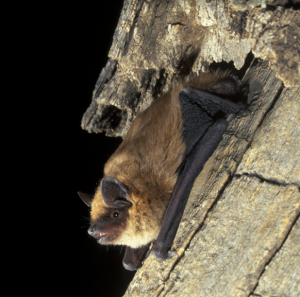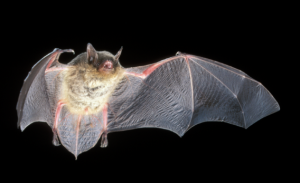
Bats occupy an important niche in ecosystems around the world, providing mosquito control, eating crop-damaging moths and beetles, pollinating important agricultural crops, and dispersing seeds to aid in reforestation. Unfortunately, this unique flying mammal faces survival challenges from habitat loss, disease, and negative perceptions. Three of the four mammals identified as threatened or endangered in Georgia are bats.
Georgia is home to 16 species of bats. At least nine of these species have an expected distribution range in the upper piedmont region, including the three endangered ones, the gray bat (Myotis grisescens), the Indiana bat (Myotis sodalist), and the northern long-eared bat (Myotis septentrionalis).
All Georgia bats are insectivores; they eat thousands of moths, beetles, mosquitoes, and other flying insects each night. This free service from bats provides over $53 billion in organic, non-toxic pest control to farmers worldwide. In a study conducted in southern Illinois in 2013 and 2014, researchers spread net enclosures over 20-by-20-meter blocks within corn fields each evening to exclude bats. Corn grown where the bats could not enter suffered 56 percent more damage from corn earworms than did corn grown where bats were free to swoop in and feed each night. Based on 2014 corn prices, researchers estimated that bats provided a world-wide agricultural benefit of $1 billion on corn alone.
Bats also eat pests of other crops, including cotton, soybeans, and pecans. After losing 30 percent of their pecan crop to the larvae of hickory shuckworm moths each year, the owners of Pebble Hill Grove pecan orchard in south Georgia started installing bat houses in 1996. By 1999, they had 11 bat houses and 2-3 thousand bats hunting through their orchard each evening – and no more problems with damage from shuckworms.

In desert and tropical environments, bats feed on pollen, nectar, and fruits. They pollinate some of our favorite foods, including bananas, cloves, and agave, as well as other socially and economically important plants. By distributing the seeds they ingest, fruit-eating bats “can account for as much as 95 percent of the seed dispersal responsible for early growth in recently cleared rainforests,” according to the U.S. Fish and Wildlife Service.
After all of their insect, pollen, and fruit consumption, bats produce a valuable product: guano. The agricultural use of droppings from birds and bats as fertilizer dates back at least to the 13th century, and guano became the first commercial fertilizer in the 1840s, when it was mined from Peruvian islands and shipped to Europe and the U.S.
The fungal disease Pseudogymnoascus destructans, abbreviated as Pd, that causes White Nose Syndrome has reduced bat populations in some Georgia caves by over 90 percent since it was first detected in Georgia in 2013. Habitat loss is another major threat to bats. Some bats now roost in structures, including homes, bridges, and culverts.
Although no one wants bats roosting in their home, they are beneficial to have around the yard for reducing numbers of mosquitoes and other flying pest insects. To encourage bats to move out of your house, install a bat house in a desirable location nearby. Then determine where bats enter the home. Sometime between August and March, when all the bats have left the roost to hunt, seal up the entry point so that the bats cannot get back inside. Avoid excluding bats between April and the end of July because the pups can’t yet fly, and they will be sealed inside the home.